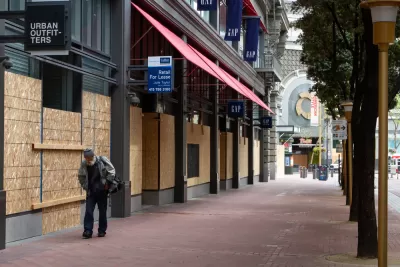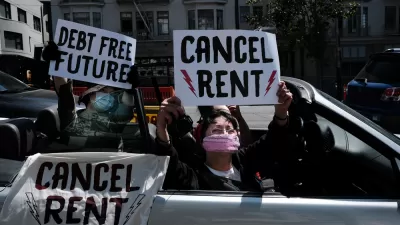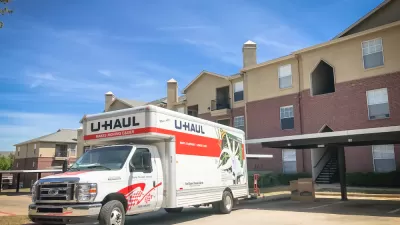One-third of tenants didn't pay rent in April, according to a data released today by the National Multifamily Housing Council.

Since states and cities started to issue stay-at-home orders and businesses began closing up shop in March, the question of how millions of Americans suddenly facing unemployment will pay rent every month remains very difficult to answer. Data tracking by the National Multifamily Housing Council, a consortium of landlords, says a large share of residential tenants, almost one-third, didn't pay rent in April. [Update: survey data, released the same by Apartment List, estimates that a quarter of Americans didn't pay rent or mortgages in April.] The share of renters unable to pay rent will likely only grow as stay-at-home orders persist into May, and possibly deeper into the summer and fall, threatening to transform the public health crisis into an economic and social crisis that outlasts the virus.
Some of the looming threat is inherited from market conditions that pre-date the appearance of the coronavirus. Millions of renters around the country spend huge portions of their wages on housing, and renters tend to be the most vulnerable Americans in terms of savings and employment. According to analysis by the Urban Institute, 21 percent of renters lacked $400 for an emergency in 2018. In the same year, only 31 percent of renters had money set aside to cover the expenses of a three-month emergency.
More and more Americans were straining to cover the high cost of housing before the pandemic, creating a major pressure point in an economy that was, according to reports, booming. According to the Joint Center for Housing Studies of Harvard University, however, 20.8 million renter households, representing 47.5 percent of all renters, paid at least 30 percent of income for housing and utilities in 2018. One in four renters, and more than half of the lowest income renters, spent more than half of their incomes on housing in 2018. Since the recovery from the Great Recession, the cost of housing has consistently risen faster than household incomes. As a result, more and more renters earn high levels of income, but even middle class renters are burdened by the cost of housing.
All of those trends were stressing the housing markets and the millions of renters in the country before stay-at-home orders gutted the employment market. On April 1, with millions of Americans suddenly unemployed, and a public health crisis weeks, or potentially months, away from its expected peak, U.S. renters owed a collective $22 billion for rent, according to analysis by CoStar.
Rent Relief So Far
Some states and cities have acted quickly to provide relief for renters by allowing tenants to defer rent payments. The most common form of relief has come in the form of an eviction moratorium, though big questions about the effectiveness of both these responses remain.
The state of New York announced a 90-day moratorium on evictions in March, suspending all eviction proceedings and any pending eviction orders. According to the Met Council on Housing, a tenants' rights organization, the moratorium "means that during this health crisis, landlords can’t sue, there will be no evictions, and all courts that hear eviction cases are closed." Moreover, the moratorium applies to residential tenants in all types of housing as well commercial tenants. Similar measures are in place in Pennsylvania and New Jersey.
Early in the pandemic, the state of California issued a moratorium on foreclosures for homeowners, while also delaying all evictions, including for residential renters, until May 31.
There's a catch, however, that critics say will undermine the intended effect of California's eviction moratorium. "To qualify, renters must have lost their job or hours at work, or have had to take care of children whose schools are closed or family members with COVID-19," writes Liam Dillon to explain in an article for the Los Angeles Times. "Tenants also must notify their landlords in writing no later than seven days after their rent is due — or by April 8 or May 8 — if they’re unable to pay."
Although Los Angeles expanded its renter relief program by also prohibiting landlords from raising rents for the 624,000 apartments that fall under the city’s rent stabilization program, critics say the efforts don't go nearly far enough in protecting renters from housing litigation and threat of eviction. As reported on April 5, also by Liam Dillon, many landlords in Los Angeles were proving eviction moratoriums ineffective. In response to pressure from advocates and news about landlords bypassing the state's eviction moratorium, the state of California's Judicial Council on April 6 took eviction protections a step further by ending all eviction actions.
The federal government is also chipping in to support the most vulnerable renters, with a one-time cash payment through the CARES Act. That money won't be paid until too late to help renters in April, and the total of $1,200 wouldn't cover rent and other necessities in many places in the United States in April or any other month.
Organizing for Rent Relief
A new era of activism has mobilized as housing and tenant advocates around the country find fault with the eviction moratorium and cash payments that have so far been the extent of the government response to the crisis.
In Los Angeles, a coalition called Healthy LA has brought together more than 250 organizations to call for a much more ambitious relief package for renters in the city, including, according to an article by Bianca Barragan, "a 'strong moratorium on evictions,' rent forgiveness, mortgage suspensions, a residential and commercial rent freeze, paid sick leave, and handwashing stations, showers, and other hygiene support 'at every informal settlement' of unhoused people."
Patrick Sisson writes that the community organizing in Los Angeles could influence groups in other parts of the country, and there are plenty of examples to choose from, like Housing Justice for All, a similar coalition of groups organizing in New York City.
A model originating in Oakland, California, with the organization called Moms 4 Housing, which reclaimed a vacant house in West Oakland in January, has been duplicated during the coronavirus pandemic. In March, a group called Reclaiming Our Homes, or the Reclaimers, took over vacant homes owned by Caltrans in El Sereno, near Pasadena.
The most widely discussed option for renters faced with the unprecedented economic stress of the pandemic, however, is the rent strike. Sam Levin and Vivian Ho reported on the growing calls for rent strikes in California at the end of March. New York renters, like many in California, perceiving the benefits of economic relief efforts tilting in favor of landlords, prepared for a rent strike at the end of March, according to an article by Jake Offenhartz. The Right to Counsel NYC Coalition and the aforementioned Housing Justice for All prepared a guide to rent strikes to respond specifically to the pandemic.
Also writing before the calendar turned to April, Henry Grabar notes that residential tenants aren't the only ones threatening to withhold rent. National commercial chains, like Mattress Firm, Subway, and the Cheesecake Factory, are playing this "nervous game of chicken."
The calls for a more complete form of rent relief, and for organized protest in response to the new housing crisis, can be tracked on social media at #CancelRent and #RentStrike2020.
There are also a few vocal politicians calling for government to go further in supporting renters. Bernie Sanders promoted a message by New York State Senator Mike Gianaris calling for rent to be canceled—a much more sweeping proposal than the rent deferments offered in the initial relief packages. Former presidential candidate and former Secretary of the U.S. Department of Housing and Urban Development Julian Castro devoted significant time during a recent CityLab interview advocating for more funding for the Housing Choice Voucher system and a monthly renters tax credit.
The idea of canceling rent brings another term into play that has been commonly mentioned in discussions about a policy response to the COVID housing crisis—the rent jubilee, a concept mentioned in the Book of Leviticus. In response to the idea of jubilee, even traditionally urbanism-focused publications and have expressed skepticism. Arguments in favor of sympathy for landlords tend to focus on two points: that many landlords are "mom and pop" businesses just as vulnerable to economic downturns as their tenants, and the importance of a healthy mortgage market.
Articles by Patrick Sisson and Kriston Capps for Curbed and CityLab, respectively, caution about the consequences of segregating the interests of landlords from the interests of tenants. The article by Capps also included the suggestion that the federal government should do more to support landlords, similar to the extra support advocates are supporting for the benefit of rental tenants.
Among the possible alternatives to rent jubilees and rent strikes are good faith negotiations between landlords and tenants, like those described in an article by Caroline Spivack:
The Rent Stabilization Association (RSA), a trade group that represents some 25,000 landlords and agents, has provided its members with information on government resources, urging them to do the same with their tenants. RSA is also encouraging landlords to negotiate payment plans with tenants who have recently suffered a loss of income, says RSA spokesperson Vito Signorile.
Some industry observers and tenant advocates are calling for landlords to be as flexible as possible. It's better to receive partial payments and negotiate future payments, according to this argument, than start all over with a new tenant, according to this line of thinking. But the terms of any such negotiation will likely be limited. For instance, it isn't always possible to lower rent, due to covenants that require specific income and debt service coverage ratios.
Some landlords, like the author of this Washington Post opinion piece, have been more generous than others in recognizing the benefit of finding ways to support tenants during the pandemic. But for every example of generosity and flexibility, there are examples of landlords making the situation much worse, like Saturn Management, a property-management company in Los Angeles, which failed to BCC all of its tenants on an email communicating a requirement to pay rent in April, thus opening itself to a rent strike. Other examples of landlords protecting their own interests above the welfare of their tenants reported in the Los Angeles Times include a landlord that suggested renters seeking temporary relief or repayment plan turn over any money from a federal stimulus check or from a charity. Others have requested pay stubs for proof of the impact of coronavirus on tenants' incomes.
"Pressure from landlords to sign repayment plans before the full effects of the coronavirus are known may lead renters already unsettled by job losses and government stay-at-home orders to sign away their rights and ultimately facilitate their own evictions, tenant advocates say," writes Liam Dillon.
With threats like these in mind, the National Multifamily Housing Council and ten other real-estate organizations wrote a letter to congressional leaders outlining recommended support for relief for beleaguered renters. "They also called for aid that would specifically benefit rental property owners, who employ some 341,000 maintenance staff, superintendents, and other workers nationwide. That’s about seven times more people than work in the coal industry, for comparison’s sake," writes Kriston Capps.
What Happens to a Rent Crisis Deferred?
"The true economic toll of all but shutting down New York City to stem the spread of the coronavirus is likely to become clearer on Wednesday when April rent is due," wrote Mathew Haag on March 31, before the data about how many renters would miss payments was available. Estimating that as many as 40 percent of New York City's 5.4 million renters won't be able to afford rent in April, Haag predicted the economic consequences of the failure of the rent system to include "landlords without enough money to pay their water and sewer bills for their properties" and a blow to the city's finances, which depend on property taxes, which are due in July.
The larger threat of renters and landlords unable to make payments now and into the future harkens back to the financial crisis of 2008, and the Great Recession that followed. According to another article by Kriston Capps, a rent jubilee could "discourage people from investing in mortgage-backed securities, since they might fear that they could lose their shirts in the event of another rent jubilee." Another failure like the fiscal crisis of 2008 would wipe out insurance companies and pension funds, so "everyday people have an interest in keeping solvent, especially right now," according to Capps.
There are already indications that some of the seeds of that terrible possibility have already been planted. "A crisis in credit markets deepened over the weekend and into Monday as a cluster of funds that own mortgage bonds sought to sell billions in assets to meet investor redemptions, sparking pleas for government intervention," according to an article by Sridhar Natarajan, Claire Boston, and Heather Perlberg for Bloomberg.
Credit markets likely seem irrelevant to tenants struggling to pay the rent after suddenly losing their jobs and facing the uncertain prospects of even being able to safely look for a new one, much less find one. According to the report released by the National Multifamily Housing Council, 69 percent of households paid their rent by April 5 this month. That ratio is "down from 81% that had paid by March 5 and 82% that did so by April 5, 2019," as explained in an article by Nelson Oliveira. A sizable number of U.S. small businesses also missed rent and mortgage payments in April. About half of U.S. small businesses hadn't paid their full rent or mortgage as of April 3, according to data collected in a poll by Alignable and reported in an article by Will Parker [paywall].
The size of the challenge facing renters, and the country collectively, only grows the longer it is deferred. The unemployment rate isn't likely to improve before the rent is due again in May, or even when it is due again June. Returning to work before the healthcare industry can treat and prevent the novel coronavirus will require personal protective equipment, space to keep physical distance while commuting and working, and the ability to test and monitor active cases while enforcing quarantines. Neither the public sector nor the private sector has given any indication of how the country will implement and coordinate at that scale to prevent the further spread of the coronavirus and a second, deadly wave of infections.
If and when renters recently out of work do return to their jobs, they'll owe their current rent in addition to the rent deferred during stay-at-home orders. They'll be working to pay the rent in a hobbled economy. This new housing crisis can only be deferred for so long. Solutions will be needed, and the sooner, the better.

Maui's Vacation Rental Debate Turns Ugly
Verbal attacks, misinformation campaigns and fistfights plague a high-stakes debate to convert thousands of vacation rentals into long-term housing.

Planetizen Federal Action Tracker
A weekly monitor of how Trump’s orders and actions are impacting planners and planning in America.

San Francisco Suspends Traffic Calming Amidst Record Deaths
Citing “a challenging fiscal landscape,” the city will cease the program on the heels of 42 traffic deaths, including 24 pedestrians.

Detroit Says Problems With Property Tax Assessments are Fixed. Advocates Disagree.
With higher-valued properties under assessed and lower-valued properties over assessed, advocates say there's still a problem with Detroit's property tax system.

Defunct Pittsburgh Power Plant to Become Residential Tower
A decommissioned steam heat plant will be redeveloped into almost 100 affordable housing units.

Trump Prompts Restructuring of Transportation Research Board in “Unprecedented Overreach”
The TRB has eliminated more than half of its committees including those focused on climate, equity, and cities.
Urban Design for Planners 1: Software Tools
This six-course series explores essential urban design concepts using open source software and equips planners with the tools they need to participate fully in the urban design process.
Planning for Universal Design
Learn the tools for implementing Universal Design in planning regulations.
Heyer Gruel & Associates PA
JM Goldson LLC
Custer County Colorado
City of Camden Redevelopment Agency
City of Astoria
Transportation Research & Education Center (TREC) at Portland State University
Jefferson Parish Government
Camden Redevelopment Agency
City of Claremont





























